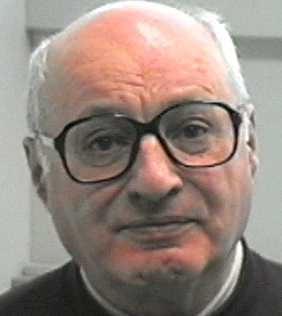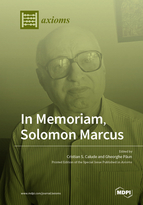In Memoriam, Solomon Marcus
A special issue of Axioms (ISSN 2075-1680).
Deadline for manuscript submissions: closed (30 September 2021) | Viewed by 18692
Special Issue Editors
Interests: algorithmic information theory; quantum computing
Special Issues, Collections and Topics in MDPI journals
Special Issue Information

In Memoriam Solomon Marcus (1925--2016)
Dear Colleagues,
Solomon Marcus (https://en.wikipedia.org/wiki/Solomon_Marcus) was a Romanian mathematician, member of the Romanian Academy, and professor at the University of Bucharest. He was a polymath with research in mathematics (mathematical analysis, measure theory, topology, mathematical and computational linguistics), theoretical computer science, poetics, linguistics, semiotics, philosophy, and history of science and education.
This Special Issue commemorates Marcus’s fifth death anniversary with a selection of articles in mathematics and theoretical computer science written by authors who work in Marcus’s research fields, some of whom have been influenced by his results and/or have collaborated with him. Marcus’s (currently last) mathematical paper was published in Axioms, https://www.mdpi.com/2075-1680/7/1/15.
Prof. Dr. Cristian S. Calude
Dr. Gheorghe Păun
Guest Editors
Manuscript Submission Information
Manuscripts should be submitted online at www.mdpi.com by registering and logging in to this website. Once you are registered, click here to go to the submission form. Manuscripts can be submitted until the deadline. All submissions that pass pre-check are peer-reviewed. Accepted papers will be published continuously in the journal (as soon as accepted) and will be listed together on the special issue website. Research articles, review articles as well as short communications are invited. For planned papers, a title and short abstract (about 100 words) can be sent to the Editorial Office for announcement on this website.
Submitted manuscripts should not have been published previously, nor be under consideration for publication elsewhere (except conference proceedings papers). All manuscripts are thoroughly refereed through a single-blind peer-review process. A guide for authors and other relevant information for submission of manuscripts is available on the Instructions for Authors page. Axioms is an international peer-reviewed open access monthly journal published by MDPI.
Please visit the Instructions for Authors page before submitting a manuscript. The Article Processing Charge (APC) for publication in this open access journal is 2400 CHF (Swiss Francs). Submitted papers should be well formatted and use good English. Authors may use MDPI's English editing service prior to publication or during author revisions.
Keywords
- mathematical analysis
- measure theory
- topology
- theoretical computer science
- mathematical and computational linguistics
- natural computing






